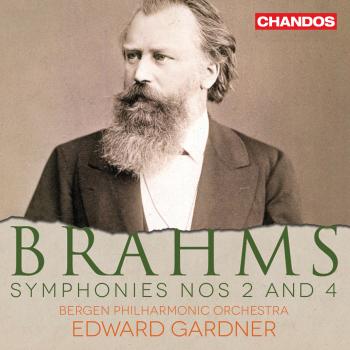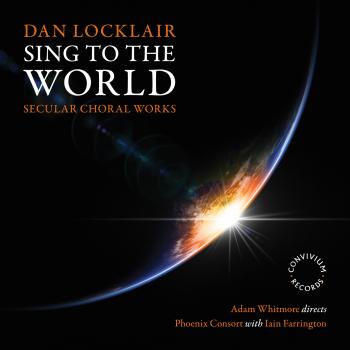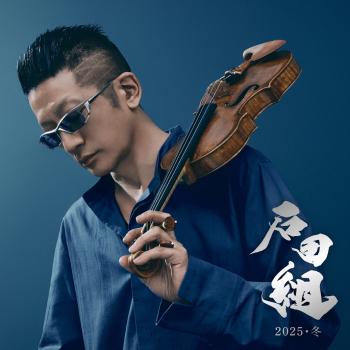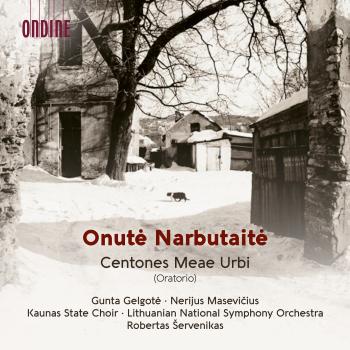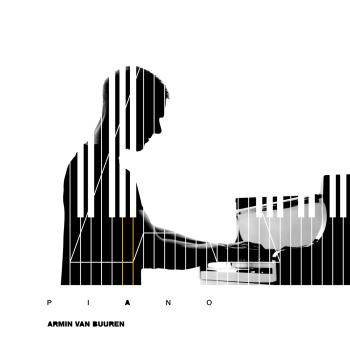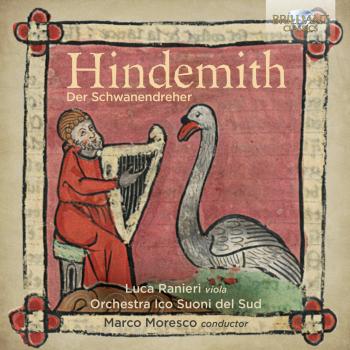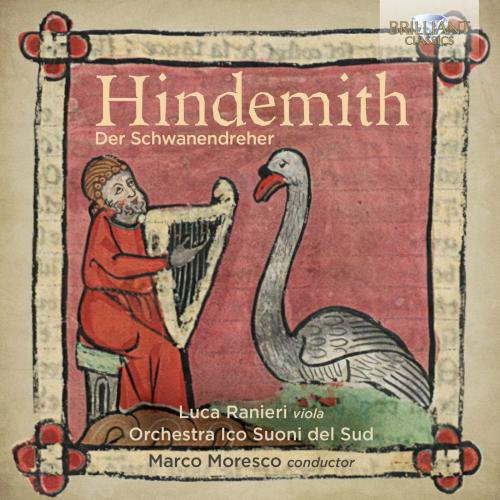
Hindemith: Der Schwanendreher Luca Ranieri, Orchestra Ico Suoni Del Sud & Marco Moresco
Album info
Album-Release:
2025
HRA-Release:
28.07.2025
Label: Brilliant Classics
Genre: Classical
Subgenre: Concertos
Artist: Luca Ranieri, Orchestra Ico Suoni Del Sud & Marco Moresco
Composer: Paul Hindemith (1895-1963)
Album including Album cover Booklet (PDF)
- Paul Hindemith (1895 - 1963): Der Schwanendreher, IPH 125:
- 1 Hindemith: Der Schwanendreher, IPH 125: I. "Zwischen Berg und tiefem Tal" (Langsam - Mäßig bewegt, mit Kraft) 08:25
- 2 Hindemith: Der Schwanendreher, IPH 125: II. "Nun laube, Lindlein, laube!" (Sehr ruhig) Fugato. "Der Gutzgauch auf dem Zaune saß" 10:33
- 3 Hindemith: Der Schwanendreher, IPH 125: III. Variationen "Seid ihr nicht der Schwanendreher" (Mäßig schnell) 09:47
- 5 Stücke, Op. 44 No. 4:
- 4 Hindemith: 5 Stücke, Op. 44 No. 4: I. Langsam 03:01
- 5 Hindemith: 5 Stücke, Op. 44 No. 4: II. Langsam - Schnell 02:12
- 6 Hindemith: 5 Stücke, Op. 44 No. 4: III. Lebhaft 01:46
- 7 Hindemith: 5 Stücke, Op. 44 No. 4: IV. Sehr langsam 04:17
- 8 Hindemith: 5 Stücke, Op. 44 No. 4: V. Lebhaft 03:35
Info for Hindemith: Der Schwanendreher
Paul Hindemith’s Der Schwanendreher (literally ‘the swan turner’) is a viola concerto based on medieval German folk songs. While the ‘swan turner’ was literally someone who turned the spit of a roasting swan, metaphorically it referred to an itinerant minstrel whose street organ or hurdy-gurdy was cranked via a swan’s-neck handle.
He composed the work between September and October 1935, and it was premiered at the Concertgebouw in Amsterdam, with the composer (a virtuoso violist who did much to elevate the instrument’s status) serving as soloist. In it, Hindemith creates a musical ‘structure’ that enhances the solo viola by contrasting it with a uniquely scored tutti ensemble of winds with four cellos and three double basses. After the slow introduction to the first movement comes a section in classic sonata form with orchestration evoking the world and art of minstrelsy.
The second movement opens with a sad dialogue between the viola and harp, inspired by an ancient song on lost love; this is followed by a contrasting fugato in which the sadness of the cuckoo (an omen of doom) is alleviated by the musical writing. The third movement features seven variations on the titular ‘Schwanendreher’ song, whose jovial, light character is skilfully rendered with iridescent rhythmic articulation.
A prolific and versatile composer, Hindemith was initially drawn to expressionism and atonal harmony before embracing a neo-Baroque style along his journey towards abstract objectivism. By the end of the first quarter of the 20th century, Hindemith had become one of the leading exponents of Gebrauchsmusik (‘Utility Music’), a musical approach designed to respond to societal needs as opposed to individual abstract aesthetic feelings.
It saw the creation of much music aimed at amateurs, though with no compromise on quality. It was in this context that Hindemith composed the set of Schulwerk für Instrumental-Zusammenspiel (Educational Music for Instrumental Ensembles) between March and April 1927. Designed for a youth orchestra, the music is by no means uninteresting or technically simple. Its fourth section is made up of the Fünf Stücke (Five Pieces) scored for a five-part string orchestra with an additional solo violin introduced in the fifth piece. While the writing remains within certain technical bounds, the score is brimming with expressive variety, rhythmic dynamism, harmonic freedom and timbral sensitivity, all of which can be recognized as hallmarks of this period in Hindemith’s compositional career.
They showcase the composer’s contrapuntal expertise, a quality particularly pronounced in the third piece, Lebhaft, with its direct connection to Johann Sebastian Bach. In these ‘teaching works’ Hindemith’s meticulous attention to detail reveals a distinctly German penchant for musical craftsmanship meeting the expectations of even ‘professional’ musicians.
Luca Ranieri, viola
Orchestra Ico Suoni del Sud
Marco Moresco, conductor
Luca Ranieri
A graduate of the “G. Verdi” Conservatory in Milan with Emilio Poggioni, he continued his studies with Bruno Giuranna, becoming one of the most important violists of his generation.
From 1993 to 1999 he was part of the Orchestra del Teatro Alla Scala, and subsequently in 1999 he became First Viola Soloist of the RAI National Symphony Orchestra, collaborating with the most prestigious conductors in the world.
He has played as a soloist with the Rai National Symphony Orchestra, the Chamber Orchestra of Padua and Veneto, I Pomeriggi Musicali di Milano, I Cameristi della Scala, I Moscow Soloists, Hessisches Orchestra Wiesbaden, Armenian Philharmonic Orchestra, Krasnojarsk Chamber Orchestra, Orchestra Sinfonica Abruzzese, I Solisti Aquilani, La Fil-Filarmonica di Milano.
In 2009 Claudio Abbado invited him to join the Lucerne Festival Orchestra.
He has performed numerous Mozart's Sinfonia Concertante with soloists such as G. Carmignola, A. Milani, D. Schwarzberg, M. Rizzi, C. Parazzoli, P. Berman.
With the Orchestra della Rai he performed the Concerto for viola by Bartók conducted by G.Phelivanian, the Hindemith concerto “Der Schwanendreher” under the direction of J.Axelrod, “Harold en Italie” under the direction of A.Lazarev, the Sinfonia Concertante by Mozart with A.Milani and the direction of C.Arming and Robert Trevino.
In 2013 he was invited to Sochi (Russia) for a concert with Yuri Bashmet and “The Moscow Soloists” for the presentation of the 2014 Winter Olympics.
He was recently in Russia to perform the Sinfonia Concertante by Mozart with the Russian violinist Sergei Dogadin (First prize gold medal Tchaikovsky competition in Moscow 2019) under the direction of Victor Tretyakov.
Invited to the 2019-2020 Symphonic Season of the Orchestra Sinfonica Abruzzese, he performed the Romance for viola and orchestra by Bruch and with the violinist Marco Rizzi the Double Concerto by Bruch under the direction of Alessio Allegrini, from this concert a CD was then produced published by the AMADEUS magazine.
In October 2021 he was invited to the closing concert of the "Moravian Festival" in Brno (Czech Republic) performing the Concerto for Viola and Orchestra by Tigran Mansurian with the Armenian National Philharmonic Orchestra conducted by its permanent conductor Eduard Topchjan.
There are many collaborations in chamber music playing in the most prestigious concert institutions with many artists including: Y.Bashmet, L.Hagen, M.Argerich, N.Znaider, M.Brunello, G.Sollima, E.Dindo, A.Meneses, V.Tretiakov, M.Rizzi, P.Berman.
With Alessandro Milani and Pierpaolo Toso he refounded the Nuovo Trio Italiano D'Archi, a name that was the glorious and historic chamber music group of Franco Gulli, Bruno Giuranna and Giacinto Caramia. A teacher in various music courses in Italy and abroad, he is a member of numerous competition juries. He created the Garda Lake Festival of which he is the artistic director.
He has recorded for the record labels: Amadeus, Brilliant Classics, Naxos, Phoenix and Movimento Classical.
For the record company DYNAMIC he recorded the Sinfonia Concertante for violin, viola and orchestra by W.A.Mozart with the violinist Alessandro Milani, considered by critics as one of the most beautiful recordings in circulation.
For many years he has been a teacher of the annual specialization course in Viola in Rome at the Suola Internazionale di Musica Avos Project.
He is a teacher of the Viola class at the "G. Cantelli" Conservatory of Novara
He plays a 2006 Filippo Fasser viola.
Booklet for Hindemith: Der Schwanendreher

